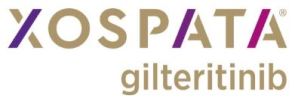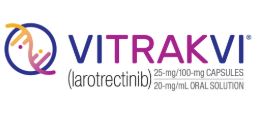Vitrakvi (larotrectinib) capsules and oral solution
Loxo Oncology
INDICATION: Treatment of adult and pediatric patients with solid tumors that:
- have a neurotrophic receptor tyrosine kinase (NTRK) gene fusion without a known acquired resistance mutation
- are metastatic or where surgical resection is likely to result in severe morbidity
- have no satisfactory alternative treatments or that have progressed following treatment
ADDRESSING UNMET NEED:
- Treatment based on a common biomarker across different types of tumors rather than location of tumor
- Treatment for cancers based on tumor genetics rather than site of origin
- New paradigm in the development of cancer drugs that are “tissue agnostic”
MECHANISM OF ACTION: Inhibitor of the tropomyosin receptor kinases (TRK), TRKA, TRKB, TRKC; TRK fusion proteins can act as oncogenic driver, promoting cell proliferation and survival in tumor cell lines
EFFICACY:
- Three multicenter, open-label, single-arm clinical trials, n= 55 pediatric and adult patients with solid tumors with NTRK gene fusion with no satisfactory alternative treatments
- Responding tumor types: Soft tissue sarcoma, salivary gland cancer, infantile fibrosarcoma, thyroid cancer and lung cancer
- Overall response rate across different types of solid tumors: 75%
- Response duration: 73% lasting at least six months, 39% lasting a year or more
SAFETY:
- Common side effects: Fatigue, nausea, cough, constipation, diarrhea, dizziness, vomiting, increased AST and ALT enzyme blood levels in the liver
- May cause harm to a developing fetus or newborn baby
REGULATORY PATHWAY: NDA
- Accelerated approval based on specific genetic feature (biomarker); continued approval contingent upon verification and description of clinical benefit in confirmatory trials
- Accelerated approval requirement: Verify and describe clinical benefit in adult and pediatric patients
- Priority Review, Breakthrough Therapy designation, Orphan Drug designation
- Rare pediatric disease priority review voucher denied

FIRDAPSE (amifampridine) tablets
Catalyst Pharmaceuticals
INDICATION: Treatment of Lambert-Eaton myasthenic syndrome (LEMS) in adults
ADDRESSING UNMET NEED:
- First treatment for LEMS
- Rare autoimmune disorder affecting connection between nerves and muscles
- Causes weakness and other symptoms in affected patients
MECHANISM OF ACTION: Not fully elucidated; broad spectrum potassium channel blocker.
EFFICACY:
- Two clinical trials, n=64 adult patients, Firdapse vs. placebo
- Endpoint: Quantitative Myasthenia Gravis score (a 13-item physician-rated categorical scale assessing muscle weakness) and Subject Global Impression (a seven-point scale on which patients rated their overall impression of the effects of the study treatment on their physical well-being)
- Patients receiving Firdapse experienced a greater benefit vs. placebo
SAFETY:
- Most common side effects: Burning or prickling sensation (paresthesia), upper respiratory tract infection, abdominal pain, nausea, diarrhea, headache, elevated liver enzymes, back pain, hypertension and muscle spasms
- Seizures and hypersensitivity reactions such as rash, hives, itching, fever, swelling or trouble breathing
REGULATORY PATHWAY: NDA
- Priority Review, Breakthrough Therapy designations, Orphan Drug designation

XOSPATA (gilteritinib) tablets
Astellas
INDICATION: Treatment of adult patients who have relapsed or refractory acute myeloid leukemia (AML) with a FMS-like tyrosine kinase 3 (FLT3) mutation as detected by an FDA-approved test
ADDRESSING UNMET NEED:
- ~ 25-30% AML patients have FLT3 gene mutation; associated with aggressive form of disease and higher risk of relapse
- First drug to be used alone in treating patients with AML having FLT3 mutation
MECHANISM OF ACTION: Inhibits multiple receptor tyrosine kinases, including FLT3
EFFICACY:
- Clinical trial, n=138 patients with relapsed or refractory AML with confirmed FLT3 mutation
- Complete remission (no evidence of disease and full recovery of blood counts) or complete remission with partial hematologic recovery (no evidence of disease and partial recovery of blood counts) : 21%
- Of the 106 patients requiring RBC or platelet transfusions; 31% transfusion-free for at least 56 days
SAFETY:
- Common side effects: Muscle and joint pain (myalgia/arthralgia), fatigue and elevated liver enzymes (liver transaminase)
- Required monitoring for posterior reversible encephalopathy syndrome, prolonged QT interval, pancreatitis (inflammation in the pancreas)
- May cause harm to a developing fetus or newborn baby.
REGULATORY PATHWAY: NDA
- Fast Track, Priority Review designation, Orphan Drug designation
- Postmarketing requirements: Clinical assessment of long-term safety and risks or rare adverse events (differentiation symdrome)

reSET-O App
Pear Therapeutics
INDICATION FOR USE: Prescription cognitive behavioral therapy intended to be used in addition to outpatient treatment under the care of a health care professional, in conjunction with treatment that includes buprenorphine and contingency management
ADDRESSING UNMET NEED:
- As part of FDA efforts to address the misuse and abuse of opioids
- New tool to help more people with opioid use disorder successfully treat their addiction
DESCRIPTION:
- App can be downloaded directly to a patient’s mobile device
- Used while participating in an outpatient Opioid Use Disorder (OUD) treatment program
- For training, monitoring and reminder tool for health care providers and patients
- Compliance reward system– such as earning special icons on a prize wheel
EFFECTIVENESS & SAFETY:
- Multi-site, unblinded, controlled 12-week clinical trial, n=170 patients, with or without reSET-O
- Supervised administration of buprenorphine and urine screens; contingency management system to reward negative urine tests
- Illicit drug use, abstinence improvement : No decrease with reSET-O vs. buprenorphine treatment and contingency management alone
- Retention in treatment program for 12 weeks: 82.4% with reSET-O vs. 68.4% without reSET-O
- Adverse events: Typical of patients with OUD – cardiovascular disease, gastrointestinal diseases, HIV, Hepatitis C, nutritional diseases, risk of overdose, depression, mania, suicidal behavior and suicidal ideation and attempts
REGULATORY PATHWAY: 510(k)
- Predicate device, reSET App- classified via De Novo pathway in 2017
- Regulation Number : 882.5801
- Classification : II
- Classification Name: Computerized Behavioral Therapy Device For Psychiatric Disorder
- Product Code: PWE

Truxima (rituximab-abbs)
Celltrion Inc.
INDICATION: Non–Hodgkin’s Lymphoma (NHL). Treatment of adult patients with:
- Relapsed or refractory, low-grade or follicular, CD20-positive, B-cell NHL as a single agent
- Previously untreated follicular, CD20-positive, B-cell NHL in combination with first line chemotherapy and, in patients achieving a complete or partial response to a rituximab product in combination with chemotherapy, as single-agent maintenance therapy
- Non-progressing (including stable disease), low-grade, CD20-positive, B-cell NHL as a single agent after first-line cyclophosphamide, vincristine, and prednisone (CVP) chemotherapy
ADDRESSING UNMET NEED & REGULATORY PATHWAY:
- First biosimilar to Rituxan (rituximab, Genentech Inc.)
- Approval based on a review of extensive structural and functional characterization, animal study data, human pharmacokinetic data, clinical immunogenicity data, other clinical data
- Demonstrated that Truxima is biosimilar to Rituxan
- Not as an interchangeable product.
Image credit: Loxo, Catalyst, Astellas, Pear, Celltrion
